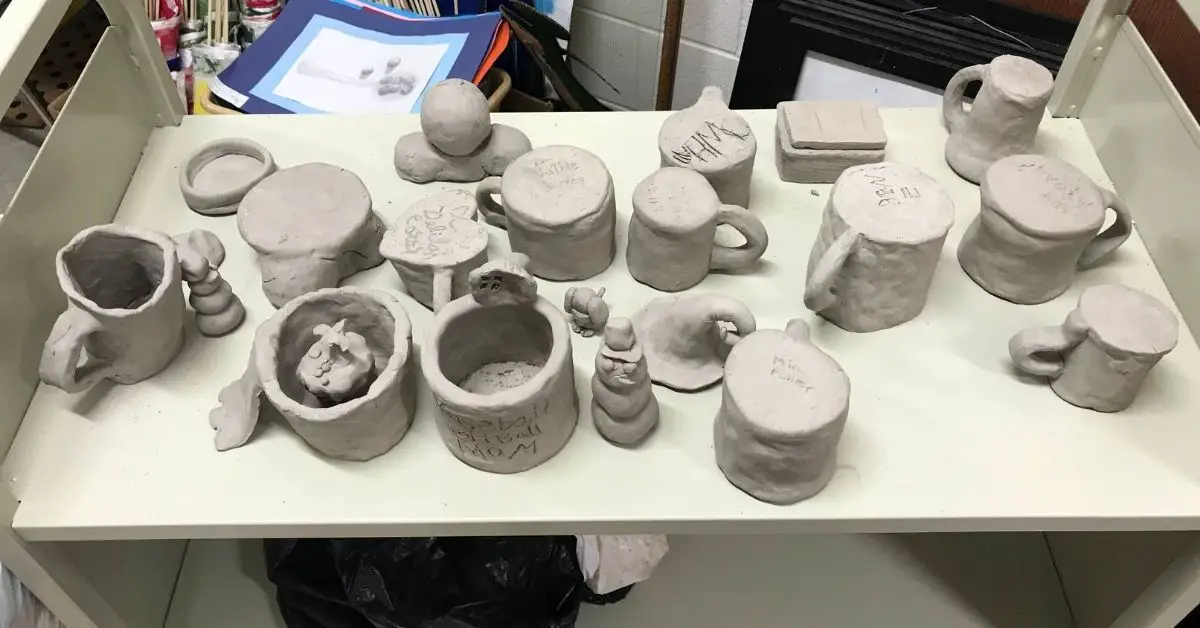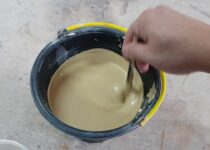Does Clay Shrink When Fired
If you’re beginning to learn about pottery or have recently had your first piece made of clay fired, you might be aware that they’re significantly smaller as they emerge from the kiln than when they first went into. Perhaps you’ve been thinking, why does clay shrink after being fired?
There are a variety of reasons clay shrinks after being fired. First, it sheds water. In addition, it goes through physical and chemical changes that cause it to become more dense than in its initial state. The more tightly packed clay particles, the smaller the clay will shrink.
Does Clay Shrink When Fired?
The process of firing is an exciting journey for clay. It undergoes amazing changes that transform it into a strong ceramic material. A common question in ceramics is, “Does clay shrink when fired?
If clay gets exposed to extreme temperatures in the kiln, it experiences a size reduction. This shrinkage occurs because of various factors, including the evaporation of water and the rearrangement of the clay’s particle sizes. As the oven heats up, the clay’s water molecules start to evaporate, which causes the clay body to shed moisture. This loss of moisture results in an overall decrease in the dimension of the clay body.
The degree of shrinkage is contingent on several variables, including what nature of the clay used, the temperature of firing and the composition of the clay body. Different types of clay have distinct shrinkage rates, with some clays shrinking faster than others. Moreover, the firing temperature is a key to determine the extent of shrinkage, as higher temperatures can cause more shrinkage.
It’s crucial to remember that the clay is shrinking in every dimension once fired, which includes width and length. The shrinkage may result in profound consequences for ceramic artists because it can affect the work’s final size, shape dimensions, and shape. Understanding the shrinkage characteristics of the clay employed is crucial to achieving desired results and avoiding unintentional results.
Artists typically consider clay shrinkage when they design their artwork and anticipate changes in shape and size when firing. Proper planning and understanding of shrinkage helps artists keep control of their designs and ensure the final product is in line with their artistic idea.

In this article, we’ll look into the science behind the shrinkage of clay when firing, explore the variables that affect the phenomenon, and provide concrete guidelines for artists to understand and use this natural process. Understanding how clay behaves when fired helps artists make informed choices, try new things with purpose and get excellent results in their ceramic projects.
Loss of water in the firing process causes the clay to shrink.
The average clay composition is 20 percent water and 9 percent organic matter. The result is that a piece fired is around 30% lighter than its initial weight.
Even though the clay is put into the kiln looking dry, it will have some water. It is water that is left over from the clay and has been chemically bound to clay particles.
After the clay has been fired, the moisture evaporates, and the chemically bound water is pushed out. The clay shrinks because of the drying-out process.
Physical and chemical changes also cause the clay to shrink.
In addition, in the process of firing, the organic matter gets burned away from the clay, which means that the clay loses a portion of its volume.
Furthermore, the clay goes through a process of vitrification throughout fire making. In simple terms, vitrification is creating glass inside the clay body while heated up inside the oven. As the clay warms, the glass forms inside the clay body.
When a piece of greenware is fired, glass forms inside ceramic particles. When the clay is heated, the glass oozes out of the clay particles through the gaps between them. This causes the clay to shrink because the particles are shrinking as the gaps between particles are filled with air.
The higher the temperature of firing increases, the more the clay is vitrified. The vitrification process occurs, meaning that clay fired at a low temperature might just be partially vitrified.
This means that spaces still exist between clay particles, and clay is semi-porous. This also means that the clay will shrink less than a piece of clay that is completely vitrified.
The higher the firing temperature, the greater the amount of clay that shrinks until it reaches the point of most excellent shrinkage.
If a clay piece shrinks as much as it can, the kiln’s temperature is still going upwards, and the clay begins to expand and bloat, then increase in size.
When the clay bloats, it will shed some of the hardness and elasticity it gains as it shrinks.
Does Clay Shrink in a Glaze Fire?
When the clay is sintered, the clay is no longer thought to be clay. Instead, it is now a ceramic. Ceramics become vitrified when they are glazed. As mentioned above, the vitrification process occurs as the temperature of the kiln rises.
When the process is in progress, some clay particles melt, forming the glass that fills the spaces between particles. This causes clay particles to move closer.
Furthermore, the particles themselves get smaller as the glass-forming characteristics are removed from the particles, and they fill the gaps in between.
The material is thicker and more porous. The clay then shrinks when fired during the glaze. The more porous ceramic is less porous, the more it shrinks when fired. For instance, porcelain which is porous when fired shrinks greater than earthenware. In contrast to earthenware, porcelain will remain semi-porous under the glaze.
Porcelain pottery turns non-porous once fired and shrinks accordingly.
Why is it so essential to allow the clay to dry slowly?
It is important to note that the bigger your piece is, the greater shrinking movements will occur. It is essential to realize that the bigger your piece is, the more crucial that it dries equally (slow drying will ensure equal drying). If one side is drying faster than the opposite, then the dry side will shrink the wetter side and put stress on the clay, causing cracks may develop. Drying clay by air contains lots of water. It’s at least 25 percent water.
As the clay begins drying and the water begins to evaporate out of it. This causes the clay particles to get more compact, leading to shrinkage. Many problems in clay are due to inconsistent drying rates, which cause stress within the clay. Sometimes this stress manifests quickly as cracks or deformations, but other times, or after the fire. This is why ensuring that the drying process is even is crucial. This can be achieved by ensuring that the piece is that the same thickness is maintained throughout the piece, which is why it takes a long time to dry and extend the drying of certain pieces.
How to Dry Your Pottery Clay?
It is often stated that the most effective way to dry out your pottery is to do it slowly and naturally. This means allowing the clay to dry naturally without hurrying it ahead.
But what’s most important is that your clay dries equally. If a portion of your pottery is drying out more quickly than the others and the clay is placed under great stress.
For instance, the handle of a mug will tend to dry faster than the entire mug. This is because the handle is more visible and has a greater surface area. If this occurs, there is a chance that the handle may split at the joint.
The reason is that as the clay dries, it shrinks. If the handle shrinks more quickly than the mug, it may lead to the handle being able to break near the point of joining.
The most important thing to do when drying your pots is to dry them uniformly. Using a plastic bag, one trick is to wrap the handles and other details, such as the edges. Also, cover the entire area with a bag to prevent draughts from drying out one part faster.
If your clay appears dry, place it in the kiln at an extremely low temperature for a few minutes. This is known as candling.

Frequently Asked Questions
What happens when the clay is heated?
When the temperature of clay rises too fast, the water will change to steam inside the clay body and expand with an explosive reaction on the clay body. At the point that the water’s boiling point (212 F and 100 C at sea level) is attained, all atmospheric water will be evaporated from the clay’s body.
How much does clay shrink after being fired?
The shrinkage incurred during the clay firing process is generally similar to the drying shrinkage. The overall shrinkage of clay will typically be approximately 8-12 per cent. The next phase that occurs after firing is called vitrification.
What does clay do after it’s fired?
If the water content of clay is pushed out through the firing process, the clay body becomes devoid of the bonding agent. Clay particles are no longer connected by water. But, the moment during the firing process when clay loses its water-based content occurs, the time when a new bonding process is initiated. This process is referred to as ‘sintering’.
How much clay can expand?
Expansive clay particles are similar to sponges. They expand when wet but shrink when dry. The more wet it gets, the larger the molecules will expand. The more dry and drier clay soil becomes, the more it expands and shrinks. Clay may expand by as much as 10% when exposed to moisture for long periods.

Being associated with art and craft field since decades as a hobbyist and life long learner has given me an opportunity to learn many new things related to art, craft, paints and pottery which i am trying to share with your guys on this website. I have expertise of being professional painter and potter for the last 20+ years
I have learned mind blowing cool tips and insights which makes me a person with ability to improvise and come up with creative ideas and solutions to make stunning and impeccable art pieces of all types which are adored by people across the globe on this website and other platform.


